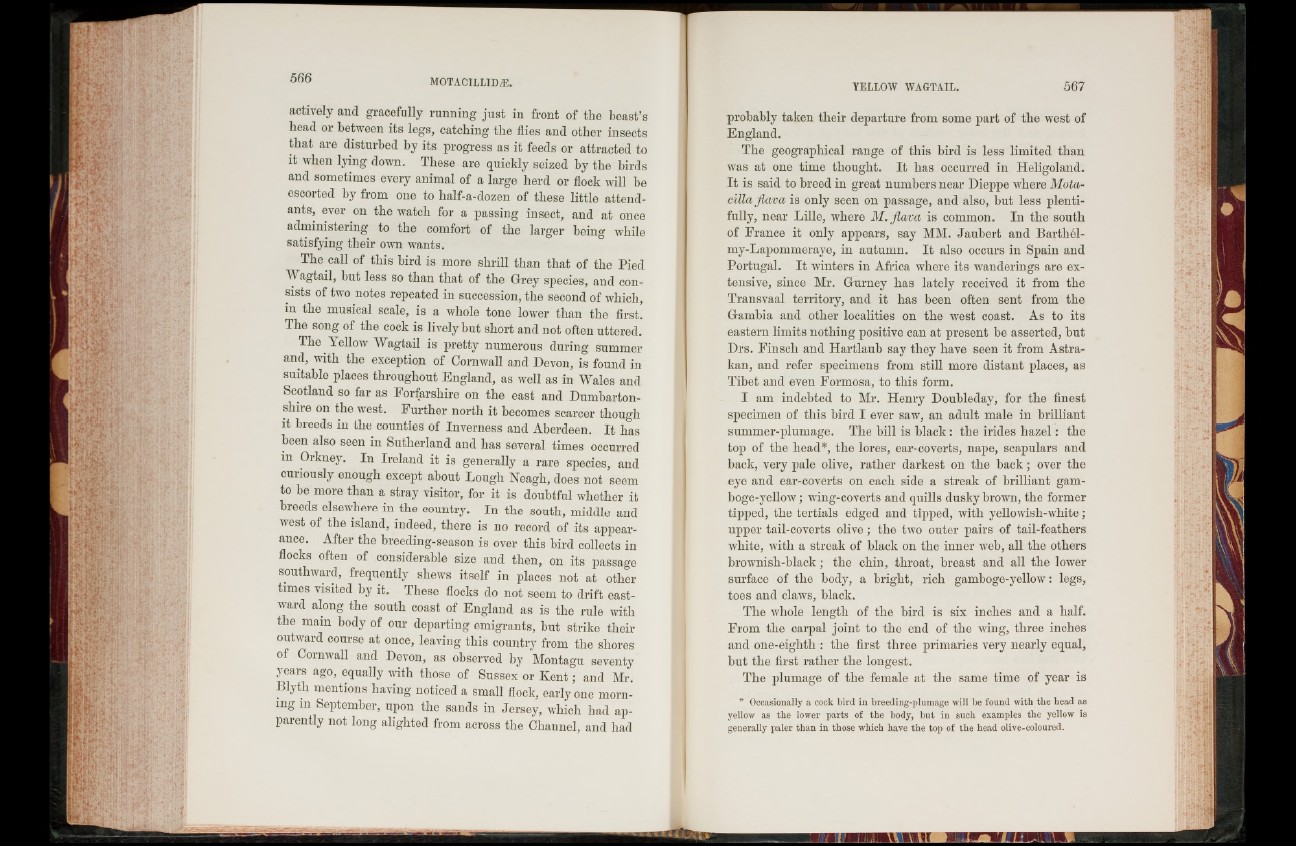
actively and gracefully running just in front of the beast’s
head or between its legs, catching the flies and other insects
that are disturbed by its progress as it feeds or attracted to
it when lying down. These are quickly seized by the birds
and sometimes every animal of a large herd or flock will be
escorted by from one to half-a-dozen of these little attendants,
ever on the watch for a passing insect, and at once
administering to the comfort of the larger being while
satisfying their own wants.
The call of this bird is more shrill than that of the Pied
Wagtail, hut less so than that of the Grey species, and consists
of two notes repeated in succession, the second of which,
in the musical scale, is a whole tone lower than the first.
The song of the cock is lively but short and not often uttered.
The lellow Wagtail is pretty numerous during summer
and, with the exception of Cornwall and Devon, is found in
suitable places throughout England, as well as in Wales and
Scotland so far as Forfarshire on the east and Dumbartonshire
on the west. Further north it becomes scarcer though
it breeds in the counties of Inverness and Aberdeen. I t has
been also seen in Sutherland and has several times occurred
m Orkney. In Ireland it is generally a rare species, and
curiously enough except about Lough Neagh, does not seem
to be more than a stray visitor, for it is doubtful whether it
breeds elsewhere in the country. In the south, middle and
west of the island, indeed, there is no record of its appearance.
After the breeding-season is over this bird collects in
flocks often of considerable size and then, on its passage
southward, frequently shews itself in places not at other
times visited by it. These flocks do not seem to drift eastward
along the south coast of England as is the rule with
the mam body of our departing emigrants, but strike their
outward course at once, leaving this country from the shores
of Cornwall and Devon, as observed by Montagu seventy
years ago, equally with those of Sussex or Kent ; and Mr.
Blyth mentions having noticed a small flock, early one morning
111 September, upon the sands in Jersey, which had apparently
not long alighted from across the Channel, and had
probably taken their departure from some part of the west of
England.
The geographical range of this bird is less limited than
was at one time thought. I t lias occurred in Heligoland.
I t is said to breed in great numbers near Dieppe where Mota-
cilla flava is only seen on passage, and also, but less plentifully,
near Lille, where M. flava is common. In the south
of France it only appears, say MM. Jaubert and Barthél-
my-Lapommeraye, in autumn. I t also occurs in Spain and
Portugal. I t winters in Africa where its wanderings are extensive,
since Mr. Gurney has lately received it from the
Transvaal territory, and it has been often sent from the
Gambia and other localities on the west coast. As to its
eastern limits nothing positive can at present be asserted, but
Drs. Finsch and Hartlaub say they have seen it from Astra-
kan, and refer specimens from still more distant places, as
Tibet and even Formosa, to this form.
I am indebted to Mr. Henry Doubleday, for the finest
specimen of this bird I ever saw, an adult male in brilliant
summer-plumage. The bill is black : the irides h a z e l: the
top of the head*, the lores, ear-coverts, nape, scapulars and
back, very pale olive, rather darkest on the back; over the
eye and ear-coverts on each side a streak of brilliant gamboge
yellow ; wing-coverts and quills dusky brown, the former
tipped, the tertials edged and tipped, with yellowish-white;
upper tail-coverts olive; the two outer pairs of tail-feathers
white, with a streak of black on the inner web, all the others
brownish-black; the chin, throat, breast and all the lower
surface of the body, a bright, rich gamboge-yellow: legs,
toes and claws, black.
The whole length of the bird is six inches and a half.
From the carpal joint to the end of the wing, three inches
and one-eiglith : the first three primaries very nearly equal,
but the first rather the longest.
The plumage of the female at the same time of year is
* Occasionally a cock bird in breeding-plumage will be found with the head as
yellow as the lower parts of the body, but in such examples the yellow is
generally paler than in those which have the top of the head olive-coloured.